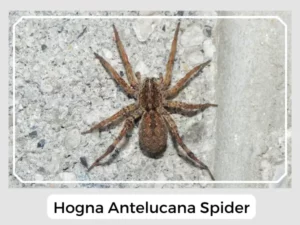The Hogna antelucana is a special kind of wolf spider found in the USA. People first noticed this spider in Austin, Texas. Like other wolf spiders, it has some cool looks and interesting ways of doing things. In this post, we’ll share awesome facts about the Hogna antelucana spider. Excited? Let’s discover together!
Fertility in this species is symbolized through their egg sac, a cocoon fabricated from fine webbing, providing protection for the embryos nestled within.
Upon emergence, these juvenile spiders display a deep connection to their maternal figure. For a significant period post-hatching, these spiderlings can be observed nestled on their mother’s back, drawing protection and warmth.
Unlike many of its arachnid counterparts, the Hogna antelucana doesn’t rely on intricate web structures to ensnare its prey. Instead, it adopts an active hunting approach, chasing and ambushing its meals.
Yes, Hogna antelucana spiders have venom. They use it to help catch the bugs they want to eat. For humans, it’s usually not too powerful.
Yes, Hogna antelucana spiders can bite. But they’re mostly peaceful and will only bite if they’re really startled or feel cornered.

Photo Credit: Scotty Astro
The wolf spider plays an instrumental role in its ecosystem. By preying on insects, it helps maintain a balance in pest populations.
Natural Predator: The Hogna antelucana hunts smaller insects but can be hunted by bigger spiders, birds, and some mammals. Its main predators are larger wolf spiders, ground-foraging birds, reptiles, and amphibians.
Prey-Predator Dynamics: Hogna antelucana hunts ants, crickets, and spiders without webs. It controls insect populations preventing plant damage.
Relationship with Humans: People might feel uneasy around Hogna antelucana because they actively hunt and are noticeable. Sometimes they accidentally enter homes. If threatened or handled, they may bite, but their venom is not very strong for humans. Most bites cause minor discomfort like a bee sting, and any redness or swelling usually goes away within a few days.
| Lifespan | Around 1 year |
| Distribution | Distributed widely across the United States, they have been spotted from the southern regions of Alabama, Florida, and Tennessee to the southwest, stretching as far as California. |
| Habitat | They’re versatile in their choice of habitat, found in varied settings from grasslands and open fields to urban locales. |
| Diet | Ants, crickets, grasshoppers, and even other spiders |
In summary, Wolf spiders, particularly Hogna antelucana, might seem intimidating, but they are vital cogs in the ecological machine.
The Hogna antelucana is a special kind of wolf spider found in the USA. People first noticed this spider in Austin, Texas. Like other wolf spiders, it has some cool looks and interesting ways of doing things. In this post, we’ll share awesome facts about the Hogna antelucana spider. Excited? Let’s discover together!
Fertility in this species is symbolized through their egg sac, a cocoon fabricated from fine webbing, providing protection for the embryos nestled within.
Upon emergence, these juvenile spiders display a deep connection to their maternal figure. For a significant period post-hatching, these spiderlings can be observed nestled on their mother’s back, drawing protection and warmth.
Unlike many of its arachnid counterparts, the Hogna antelucana doesn’t rely on intricate web structures to ensnare its prey. Instead, it adopts an active hunting approach, chasing and ambushing its meals.
Yes, Hogna antelucana spiders have venom. They use it to help catch the bugs they want to eat. For humans, it’s usually not too powerful.
Yes, Hogna antelucana spiders can bite. But they’re mostly peaceful and will only bite if they’re really startled or feel cornered.

Photo Credit: Scotty Astro
The wolf spider plays an instrumental role in its ecosystem. By preying on insects, it helps maintain a balance in pest populations.
Natural Predator: The Hogna antelucana hunts smaller insects but can be hunted by bigger spiders, birds, and some mammals. Its main predators are larger wolf spiders, ground-foraging birds, reptiles, and amphibians.
Prey-Predator Dynamics: Hogna antelucana hunts ants, crickets, and spiders without webs. It controls insect populations preventing plant damage.
Relationship with Humans: People might feel uneasy around Hogna antelucana because they actively hunt and are noticeable. Sometimes they accidentally enter homes. If threatened or handled, they may bite, but their venom is not very strong for humans. Most bites cause minor discomfort like a bee sting, and any redness or swelling usually goes away within a few days.
| Lifespan | Around 1 year |
| Distribution | Distributed widely across the United States, they have been spotted from the southern regions of Alabama, Florida, and Tennessee to the southwest, stretching as far as California. |
| Habitat | They’re versatile in their choice of habitat, found in varied settings from grasslands and open fields to urban locales. |
| Diet | Ants, crickets, grasshoppers, and even other spiders |
In summary, Wolf spiders, particularly Hogna antelucana, might seem intimidating, but they are vital cogs in the ecological machine.